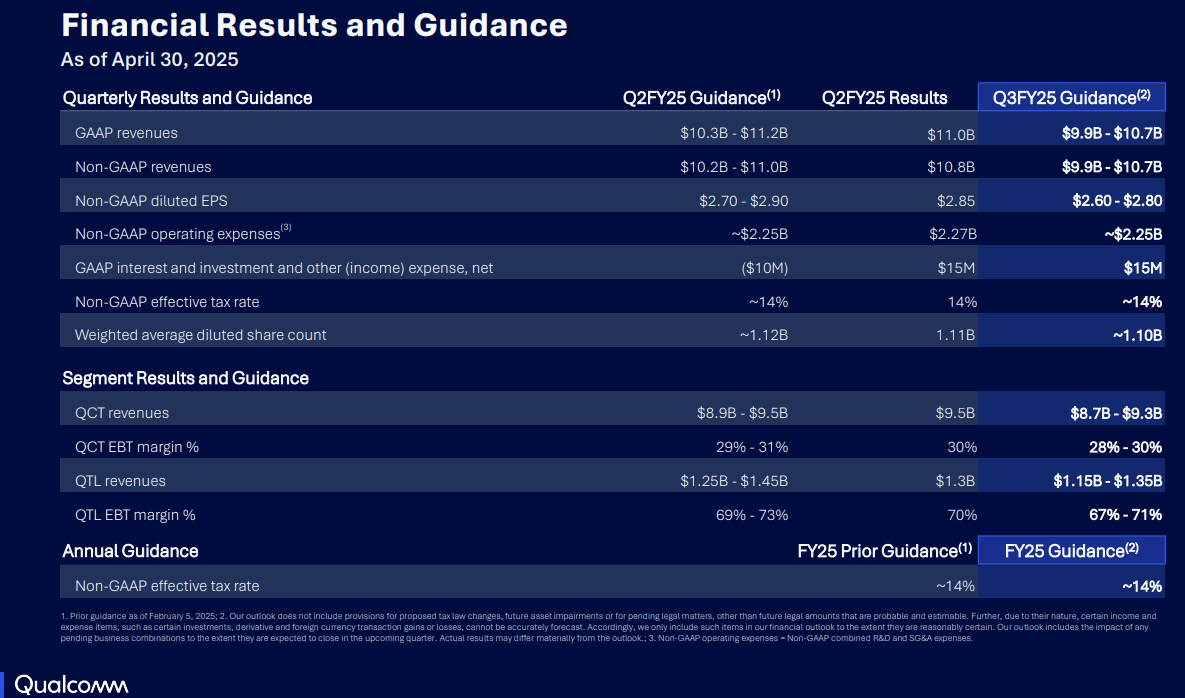AInvest Newsletter
Daily stocks & crypto headlines, free to your inbox
Qualcomm posted strong fiscal Q2 2025 earnings that exceeded Wall Street expectations on both earnings and revenue, driven by impressive year-over-year growth in its automotive and
segments. Yet despite the headline beats, shares fell as much as 6% in post-earnings trading, underperforming broader tech peers. The key culprit appears to be cautious Q3 guidance, lingering uncertainty around tariffs and trade policy, and ongoing concerns about a looming revenue loss from Apple. While Qualcomm’s diversification strategy continues to gain traction, the near-term macro backdrop appears to be muddying the bull case for investors.The company directly addressed the impact of tariffs on its business, a growing concern amid escalating U.S.-China tensions.
CFO Akash Palkhiwala noted on the earnings call that while Q2 did not see elevated orders ahead of any trade action, guidance for Q3 reflects its "current assessment of financial impact from tariffs". CEO Cristiano Amon emphasized Qualcomm’s globally diversified supply chain, adding that the company is experienced in navigating policy uncertainty. Still, the tariff overhang remains, especially given Washington’s indication that chips may be included in upcoming sector-specific tariffs.For Q2, Qualcomm reported adjusted EPS of $2.85, matching the high end of estimates and above the $2.82 consensus. Revenue came in at $10.84 billion, up 15% year-over-year and ahead of the $10.66 billion forecast. Operating income rose 16% to $3.69 billion. However, Q3 guidance fell short of expectations: revenue is expected between $9.9 billion and $10.7 billion, with adjusted EPS in the $2.60–$2.80 range, compared to consensus of $10.33 billion and $2.67, respectively. The midpoint of revenue guidance was slightly below analysts' forecasts, and that appeared to rattle a market increasingly sensitive to forward outlooks.

By business line, Qualcomm’s QCT segment (chips) posted revenue of $9.47 billion, up 18% year-over-year. Within QCT, handset revenues rose 12% to $6.93 billion, IoT revenue grew 27% to $1.58 billion, and automotive surged 59% to $959 million. Management highlighted strong design momentum in autos—30 new design wins this quarter, including five ADAS programs—as a pillar of long-term diversification. Meanwhile, the QTL licensing business remained flat year-over-year at $1.32 billion, slightly below expectations.
Qualcomm’s strategy to reduce reliance on smartphone chips and diversify into automotive, IoT, PCs, and XR (extended reality) is showing tangible progress. The non-handset portion of QCT grew 38% y/y in Q2, compared to just 12% for smartphones, lifting non-handset mix to 27%. The company reiterated its $22 billion target for non-smartphone QCT revenue by FY29 and expressed confidence in reaching $4 billion in PC revenue and $2 billion in XR revenue over the same horizon. However, while diversification momentum is building, it hasn’t yet offset concerns tied to expected declines in Apple-related revenue in the back half of 2025.

The broader macro and competitive commentary was also a mixed bag. Qualcomm acknowledged that the high-end Android market is benefiting from Chinese subsidies, which is helping the premium tier expand. However, the company flagged no major demand pull-forward and stated that visibility remains limited given trade tensions and macro headwinds. Ongoing negotiations with Huawei for licensing revenue remain unresolved. Additionally, Qualcomm’s gross margin was pressured by product mix, and OpEx levels remain high despite upcoming top-line pressures.
So why did the stock sell off when results beat and the long-term vision remains intact? The answer appears to lie in the near-term setup: muted guidance, macro uncertainty, and concerns about operating leverage. JPMorgan noted that with earnings growth drivers for the smartphone market capped and Apple’s contribution fading, the stock may face near-term pressure despite strong execution. Qualcomm does plan to return 100% of its free cash flow to shareholders in FY25 via dividends and buybacks, which could provide support. Indeed, $2.7 billion was returned in Q2 alone, including $1.7 billion in share repurchases.
Technically, the stock is sitting on its 20-day moving average, making this a potential bounce area for traders looking for a mean reversion play. Despite the post-earnings selloff, Qualcomm remains one of the more reasonably valued large-cap semis, trading at a discount to both the SOX index and the broader S&P 500. Analyst sentiment remains largely supportive, with price targets near $185, reflecting belief in the company's diversification efforts and AI roadmap.
In short, Qualcomm delivered another solid quarter operationally, but a cautious forward view, coupled with trade policy risk and limited earnings leverage in the short run, weighed on the stock. For long-term investors, the story remains one of transformation. But in the near term, Qualcomm’s ability to navigate global uncertainty and sustain top-line growth without
will be closely scrutinized.Senior Analyst and trader with 20+ years experience with in-depth market coverage, economic trends, industry research, stock analysis, and investment ideas.

Dec.12 2025
_fe7887fa1765548297996.jpeg?width=240&height=135&format=webp)
Dec.12 2025

Dec.11 2025

Dec.11 2025
_e751887c1765462367449.jpeg?width=240&height=135&format=webp)
Dec.11 2025
Daily stocks & crypto headlines, free to your inbox
Comments
No comments yet